Serving 226 students in grades Prekindergarten-8, Kipling Elementary School ranks in the bottom 50% of all schools in Illinois for overall test scores (math proficiency is bottom 50%, and reading proficiency is bottom 50%).
The percentage of students achieving proficiency in math is ≤5% (which is lower than the Illinois state average of 28%). The percentage of students achieving proficiency in reading/language arts is 15-19% (which is lower than the Illinois state average of 30%).
The student:teacher ratio of 12:1 is lower than the Illinois state level of 13:1.
Quick Stats (2025)
- Grades: Prekindergarten-8
- Enrollment: 226 students
- Student:Teacher Ratio: 12:1
- Overall Testing Rank: Bottom 50% in IL
- Math Proficiency: ≤5% (Btm 50%)
- Reading Proficiency: 15-19% (Btm 50%)
- Science Proficiency: 30-39% (Btm 50%)
- Source: National Center for Education Statistics (NCES), IL Dept. of Education
Top Rankings
Kipling Elementary School ranks among the top 20% of public schools in Illinois for:
Category
Attribute
Most improved public schools
Percent Eligible For Free Lunch
School Overview
Kipling Elementary School's student population of 226 students has declined by 20% over five school years.
The teacher population of 19 teachers has grown by 5% over five school years.
Grades Offered
Grades Prekindergarten-8
Total Students
226 students

Gender %

Total Classroom Teachers
19 teachers
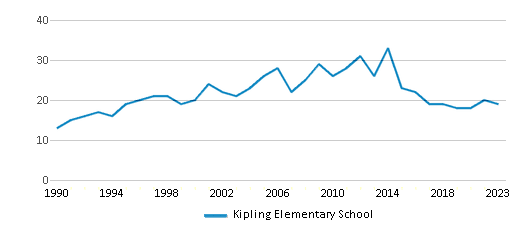
Students by Grade
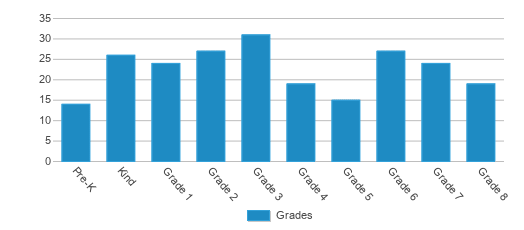
School Rankings
Kipling Elementary School ranks within the bottom 50% of all 3,426 schools in Illinois (based off of combined math and reading proficiency testing data).
The diversity score of Kipling Elementary School is 0.06, which is less than the diversity score at state average of 0.70. The school's diversity has stayed relatively flat over five school years.
Overall Testing Rank
#2749 out of 3426 schools
(Bottom 50%)
(Bottom 50%)

Math Test Scores (% Proficient)
(20-21)≤5%
28%
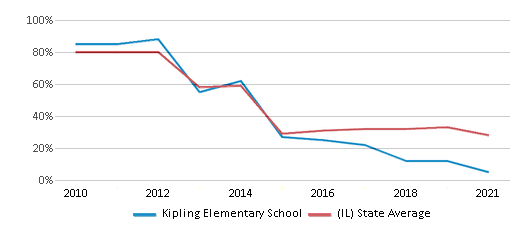
Reading/Language Arts Test Scores (% Proficient)
15-19%
30%
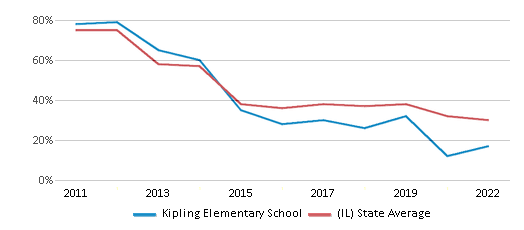
Science Test Scores (% Proficient)
30-39%
50%
Student : Teacher Ratio
12:1
13:1

American Indian
1%
1%
Asian
n/a
6%
Hispanic
2%
28%
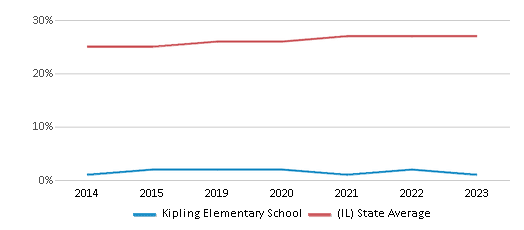
Black
97%
16%
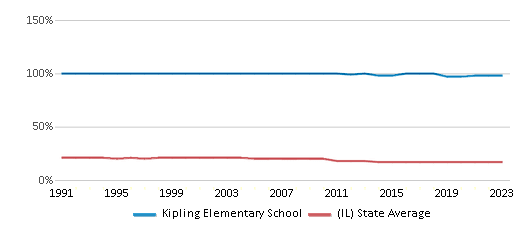
White
n/a
45%
Hawaiian
n/a
n/a
Two or more races
n/a
4%
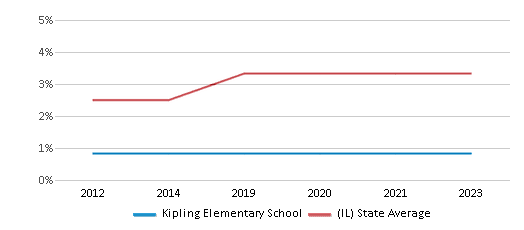
All Ethnic Groups
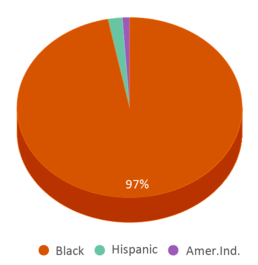
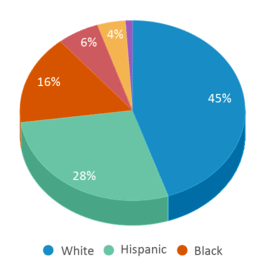
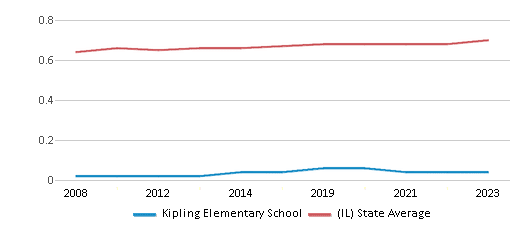
Eligible for Free Lunch
100%
43%
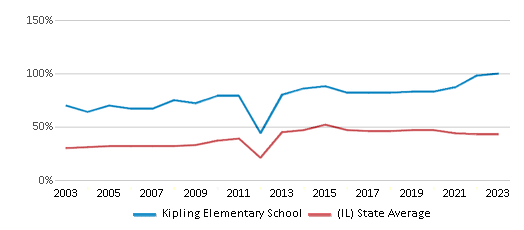
Eligible for Reduced Lunch (12-13)
7%
5%
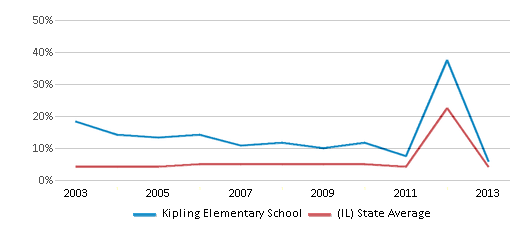
School Statewide Testing
School District Name
Source: National Center for Education Statistics (NCES), IL Dept. of Education
Profile last updated: 02/09/2025
Frequently Asked Questions
What is Kipling Elementary School's ranking?
Kipling Elementary School is ranked #2749 out of 3,426 schools, which ranks it among the bottom 50% of public schools in Illinois.
What schools are Kipling Elementary School often compared to?
Kipling Elementary Schoolis often viewed alongside schools like Gillespie Elementary School by visitors of our site.
What percent of students have achieved state testing proficiency in math and reading?
≤5% of students have achieved math proficiency (compared to the 28% IL state average), while 15-19% of students have achieved reading proficiency (compared to the 30% IL state average).
How many students attend Kipling Elementary School?
226 students attend Kipling Elementary School.
What is the racial composition of the student body?
97% of Kipling Elementary School students are Black, 2% of students are Hispanic, and 1% of students are American Indian.
What is the student:teacher ratio of Kipling Elementary School?
Kipling Elementary School has a student ration of 12:1, which is lower than the Illinois state average of 13:1.
What grades does Kipling Elementary School offer ?
Kipling Elementary School offers enrollment in grades Prekindergarten-8
What school district is Kipling Elementary School part of?
Kipling Elementary School is part of Chicago Public Schools Dist 299 School District.
In what neighborhood is Kipling Elementary School located?
Kipling Elementary School is located in the Washington Heights neighborhood of Chicago, IL. There are 10 other public schools located in Washington Heights.
School Reviews
2 5/17/2010
Truly Kipling does not take the best interest of the students in mind. They don't care about what's best for the students; they do what they want to do.
2 3/15/2010
I agree whole heartedly with the previous commentor. Kipling is the worst school I have ever experienced. They do keep parents out of their childs educational loop. Kipling feels that they know what is best for YOUR child and they will tell the parents one thing while they are doing something totally different. They hide very pertinent information from parents. I have also experienced them telling my kids not to tell me whats going on in their classes. This is bad; and the District Officer of Kipling doesn't care as well. I have called and complained about Kipling and nothing was done. The food served at Kipling is not worth dogs eating. Kipling is always sending notices home asking for money and uses the money for personal gains instead.
Review Kipling Elementary School. Reviews should be a few sentences in length. Please include any comments on:
- Quality of academic programs, teachers, and facilities
- Availability of music, art, sports and other extracurricular activities
Recent Articles

What Is A Charter School?
Explore the world of charter schools in this comprehensive guide. Learn about their history, how they operate, and the pros and cons of this educational innovation. Discover key facts about charter schools, including admission policies, demographics, and funding, as well as what to look for when considering a charter school for your child.

10 Reasons Why High School Sports Benefit Students
Discover the 10 compelling reasons why high school sports are beneficial for students. This comprehensive article explores how athletics enhance academic performance, foster personal growth, and develop crucial life skills. From improved fitness and time management to leadership development and community representation, learn why participating in high school sports can be a game-changer for students' overall success and well-being.

February 05, 2025
Understanding the U.S. Department of Education: Structure, Impact, and EvolutionWe explore how the Department of Education shapes American education, from its cabinet-level leadership to its impact on millions of students, written for general audiences seeking clarity on this vital institution.





